This article discussed methods for troubleshooting when you get an error that is accompanied by text that reads, “Low Sample Flow Rate”. There are several possible causes for this, but all of them in some way stem from a device in the Bloodhound called the “Flow Meter”…basically an in-line anemometer which is installed in the “real-time” gas flow circuit and which measures air flow the line.
PREREQUISITES:
These are the requirements before setting up H2S on your Bloodhound:
1) You must be at the location with the bloodhound – this is not a remote tutorial.
2) You will need a Phillips-Head screwdriver.
3) This tutorial assumes you know how to check and set registers on the Bloodhound (see the end of this article for links to other articles of interest if you do not).
4) You need to know the length of your line (roughly is fine – in hundreds of feet or 30-meter sections).
5) Ideally, you would have recorded the vacuum throughout the well and have a good idea of what “normal” vacuum is for this unit; however, if you did not, we can calculate this based on the length of the line (take note of this for future wells with the Bloodhound though – writing down the “vital stats” from the “real-time” data window in iBall Instruments Gas Chart software is a good way to future-proof things. We recommend: Sample Vacuum, Flow Rate (Sample LPH), Motor Speed (%), and Column Temp).
6) A basic knowledge of algebra is helpful if you have to use the formula below to calculate your sample vacuum target range.
7) The “manual tuning” section of this tutorial which uses an algebra calculation to figure out a “target range” of vacuum relies on the use of quarter-inch/six-millimeter (1/4″/6mm) diameter polyflow tubing. If you are using a different diameter, that calculation will not work for you.
8) It would be helpful to have iBall Instruments Gas Chart software installed and connected to the Bloodhound. This article also assumes you have a basic working knowledge of this software – particularly the “Real-Time Data” section.
9) The step below that involves overriding the flow meter requires that the vacuum sensor is working properly. If it is not, nothing can be done and the unit needs to be returned to the iBall Service Center for repairs.
CAUTIONS/RISKS:
Depending on the outcome, there are several things to take into consideration once any modifications have been done with regard to this tutorial:
1) If you end up over-riding the flow meter, it is advised that you complete the well and then send the Bloodhound in for repair. A stuck or sticky flow meter generally requires the shop to either retrofit the part with a new flow meter and/or clean it with a manufacturer-approved solvent. Either way, it should be sent in because putting it on a new well in its current state creates a “wild card” situation with regard to the next rig-up.
2) The Bloodhound uses a 12-volt power system. While it is generally a low-risk scenario to open the machine and work on the inside while it is running, there *is* direct wall-current (120V/240V AC depending on your region) that comes into the unit, and there are risks associated with this. If you are uncomfortable with opening the unit to work on it while running, it is better to skip that step and override the unit’s flow meter, then send it to the iBall repair shop to troubleshoot the interior after the well’s completion.
HOW-TO:
This tutorial goes through a number of steps – checking to see if the flow meter is stuck or merely “sticky”…if it is stuck, checking to see if it’s just “between fins” and attempting to manually get it to kick over…and eventually overriding the flow meter entirely and running the unit based on a calculated vacuum rate.
1) Make sure the Sample Line is not Blocked Entirely: One of the things that can create zero (0) LPH/flow rate is if the line is blocked entirely. Basically, if the line is blocked there will be no flow no matter how hard the pump is pulling (makes sense if you think about it).
a) The first thing you want to check is the vacuum (mmHg on the Bloodhound’s LCD panel, or “Sample Vac” in iBall Instruments Gas Chart software on the “Real-Time Data” screen). If the vacuum is excessive (higher than -150 for example) you may have a blocked sample line.
b) Another diagnostic you can run along this line is to simply pull the sample inlet line and see if after a few minutes the flow rate rises enough to remove the “Low Sample Flow Rate” alarm. If it does, there may be a partial restriction (kink, ice, dirty filter, partially-taped joint, etc.) in the line that is slowing the flow enough to throw the alarm, but not producing enough vacuum to throw the vacuum alarm.
c) If you have excessive vacuum (more than -200 for example) and do NOT have a “Blocked Sample Line” alarm showing, this indicates someone has turned off the “Blocked Sample Line” by setting register 52 to zero. THIS IS BAD. If this is the case, set register 52 back to 200 (its default) and troubleshoot from the start.
NOTE: If the high-vacuum alarm has been disabled, what can happen is that the Bloodhound’s pump motor will chug against the clog over and over and could suck mud into the Bloodhound (a very expensive repair), or damage the pump motors (which are also not cheap to replace). It is *far* more important to troubleshoot a blocked sample line properly than to shut off the alarm and avoid it.
2) Initial Analysis of the “Low Sample Flow Rate” Condition: We do this to see if the settings on the Bloodhound are just not keeping up with the current rig-up. For example, if a Bloodhound was setup to override the flow meter in the past with a rig-up that included 100 feet (30m) of polyflow line, but this well has 400′ (120m), then the flow rate would be very low. This can only happen if the override was done incorrectly (the flow alarm and/or regulated rate were not turned off and only the motor was overridden), and if the Bloodhound was not returned to the shop after the determination was made that the flow meter was indeed in need of service (we recommend returning the Bloodhound after the well once this has been done).
a) There are three registers of importance in relation to the Bloodhound’s automatically-regulated flow-rate. In an ideal situation (meaning the Bloodhound is in perfect operating order), what happens is the motor is not set to a specific speed, but rather is automatically changed to drive a “flow rate” that is measured by the flow meter.
NOTE: the prescribed flow-rate for the Bloodhound is 60 Liters Per Hour/LPH). If the flow-rate drops below a threshold described in the “alarm” register (register 51), then you get the “Low Sample Flow Rate” alarm on the Bloodhound.
A table of these three registers, their descriptions, and possible values lies below:
| register | WHAT IT DOES | VALID VALUES |
| 10 | Regulates the sample pump motor speed (in %). At 100%, it is running the motor at 50% of its operable speed. In engineering terms, this does not equate to 50% speed – it means 50% as an arbitrary voltage number withing the motor’s operating range.
NOTE: DO NOT EVER SET THIS OVER 180. |
DEFAULT: 0 (allows flow-meter to regulate the motor. If flow meter (register 11) is also set to zero, turns the sample motor off)
Range: 0 to 200 |
| 11 | Regulated Flow Rate. This is the Sample Flow Rate (Sample LPH) to which the flow meter will attempt to regulate the Bloodhound by automatically adjusting the motor speed (Motor %).
NOTE: DO NOT EVER SET THIS OVER 160 |
DEFAULT: 60 (tells the flow meter to regulate the motor at a speed that will produce 60 Liters-Per-Hour of flow rate).
RANGE: 0 (off) to 255 (full power to the sample motor). |
| 51 | Low Flow Rate Alarm Threshold. When the Sample Flow Rate (Sample LPH) dips below the number contained in this register, the alarm will sound and the “Low Sample Flow Rate” alarm will be displayed | Default: 20
RANGE: 0 (turn alarm off) to 20 lph |
3) Check to see if the Bloodhound’s Sample Pump has already been overridden.
a) We need to check register 10 to see if there is a “fixed-rate” motor speed that is currently being applied to the Bloodhound. Press the “Up” and “Down” arrows on the Bloodhound’s face respectively – a “SETUP MENU” will appear on the unit’s LCD:
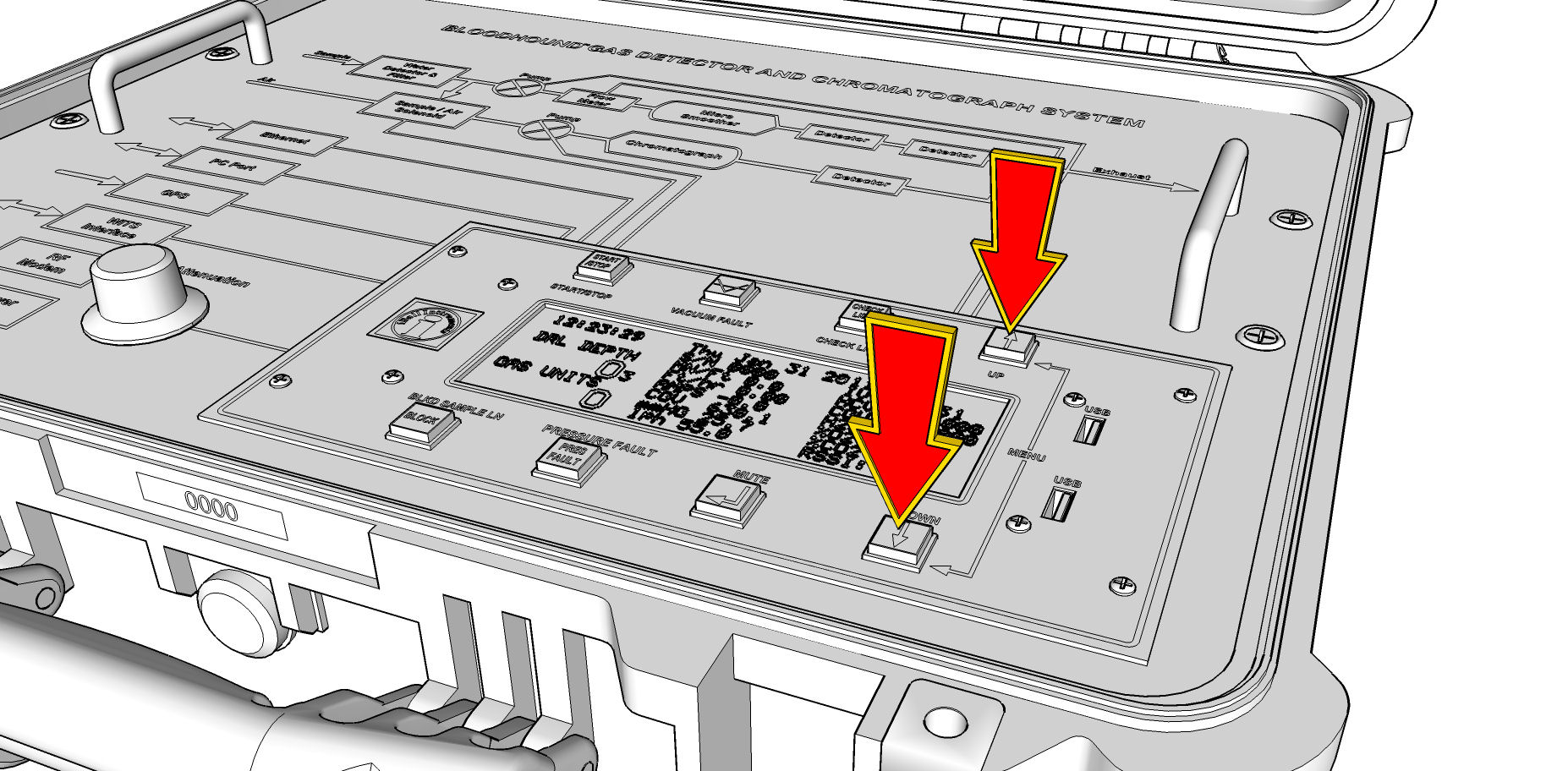
b) Use the “up” and “down” arrow buttons to go to the “register SETUP” menu item.
c) Press the “Enter/Mute” button to select this menu.
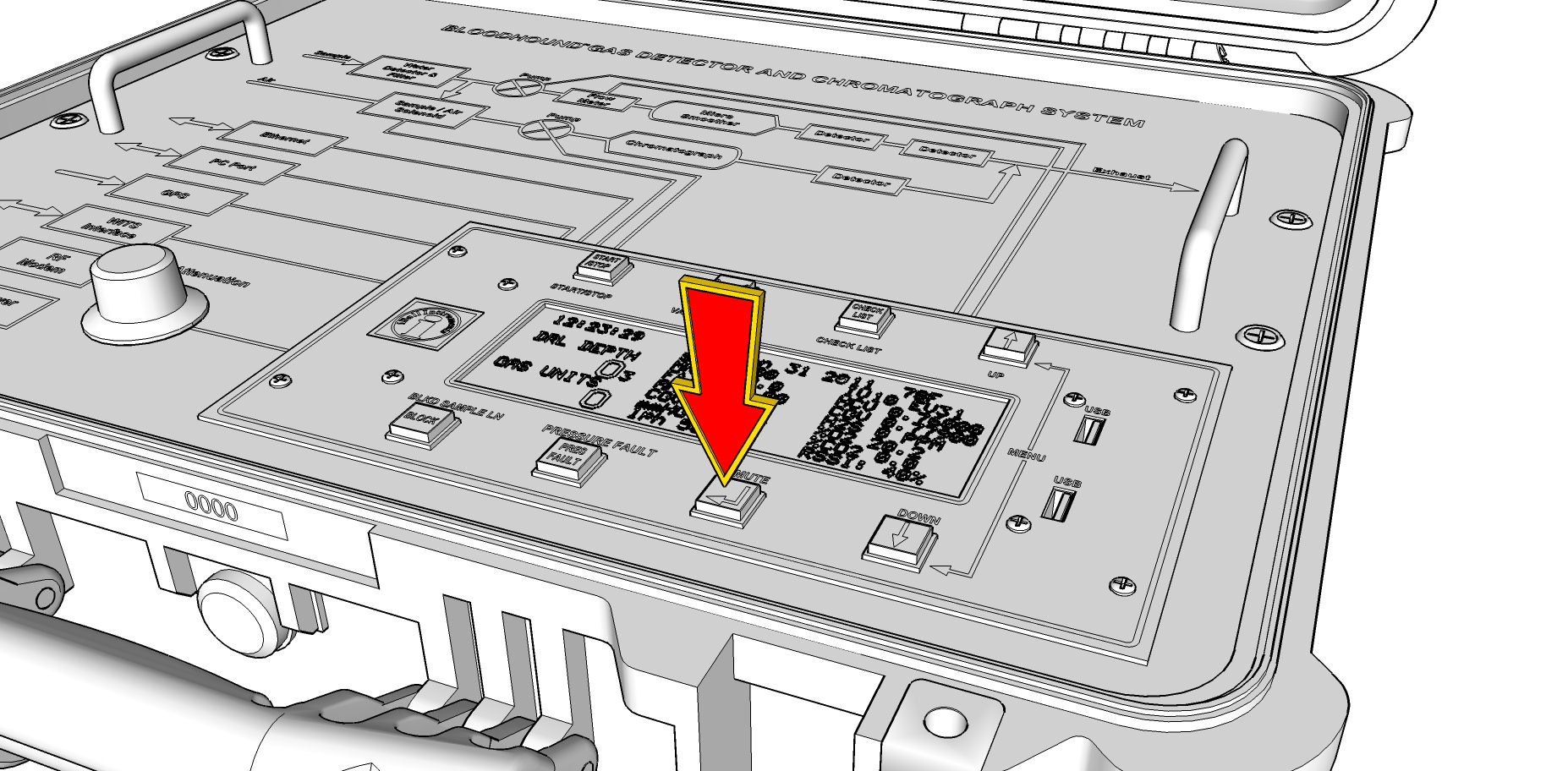
d) You will be shown a “register Number” and a “register Value”…the “register Number” will be highlighted. Use the “up” and “down” arrow buttons to go to register 10.
e) Check the display on the LCD…if the “register Value” displays “0”, then the motor speed has not been over-ridden and you can continue to Step 4 below; otherwise, continue on to (f) below.
f) If the unit has already been over-ridden, write down the number you have found here, and also look up and record the values for registers 11 and 51. Also, check the Sample LPH reading (either in the Bloodhound’s LCD display or via the real-time data window in iBall Instruments Gas Chart software) and write this all down. After you have that information, contact your to see if you can learn why it was overridden in the past. If no reason can be found, continue to “Step 4” below; otherwise, adjust accordingly.
4) Check if the flow meter is stuck, or sticky:
a) Look at the “Sample LPH” reading, either on the Bloodhound’s LCD or on the real-time data section of your iBall Instruments Gas Chart Software.
b) If it reads Zero (0) it is stuck and you should continue to “Step 5” below.
c) If it reads something other than zero (0), then it is sticky…watch it for a few minutes to see what it’s doing. If it’s steadily stuck at a given number, return to “Step 3” above and make sure the unit has not been over-ridden. If the flow-rate is climbing and falling the meter is too sticky to fix and should be over-ridden so skip to “Step 6” below.
5) Try to “kickstart” the sticky, but not completely stuck flow meter: This goes on the premise that the flow meter may have been shut down and stopped turning at the *exact* point where the fins are between the inlet; hence creating a miniature eddy in the air flow which actually stops the otherwise perfectly-operating flow meter in its place.
a) Using a Philips-Head Screwdriver, remove the four screws located on the top face of the Bloodhound located just to the outside of the chrome “handles” (see figure below):
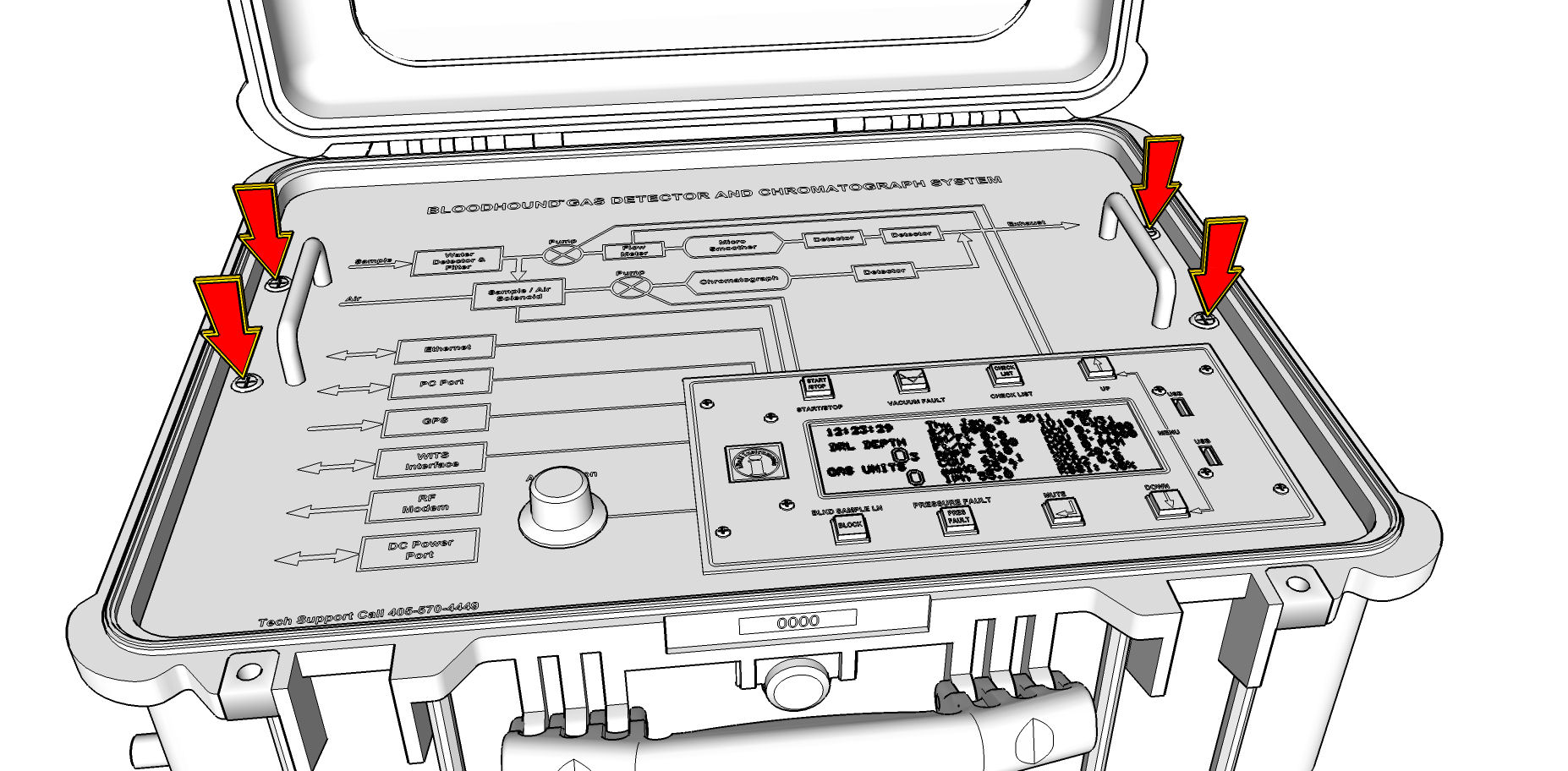
b) Carefully lift the lid toward you from the back making sure no wires or other connections come loose in the process.
c) Identify the flow meter. It is a greenish/goldisy-gray module with an attached reddish electrical housing located (if you are facing the Bloodhound from the front) to the left of the red aluminum block (called the “HRM”) near the center on the bottom of the interior of the Bloodhound (see the picture below).
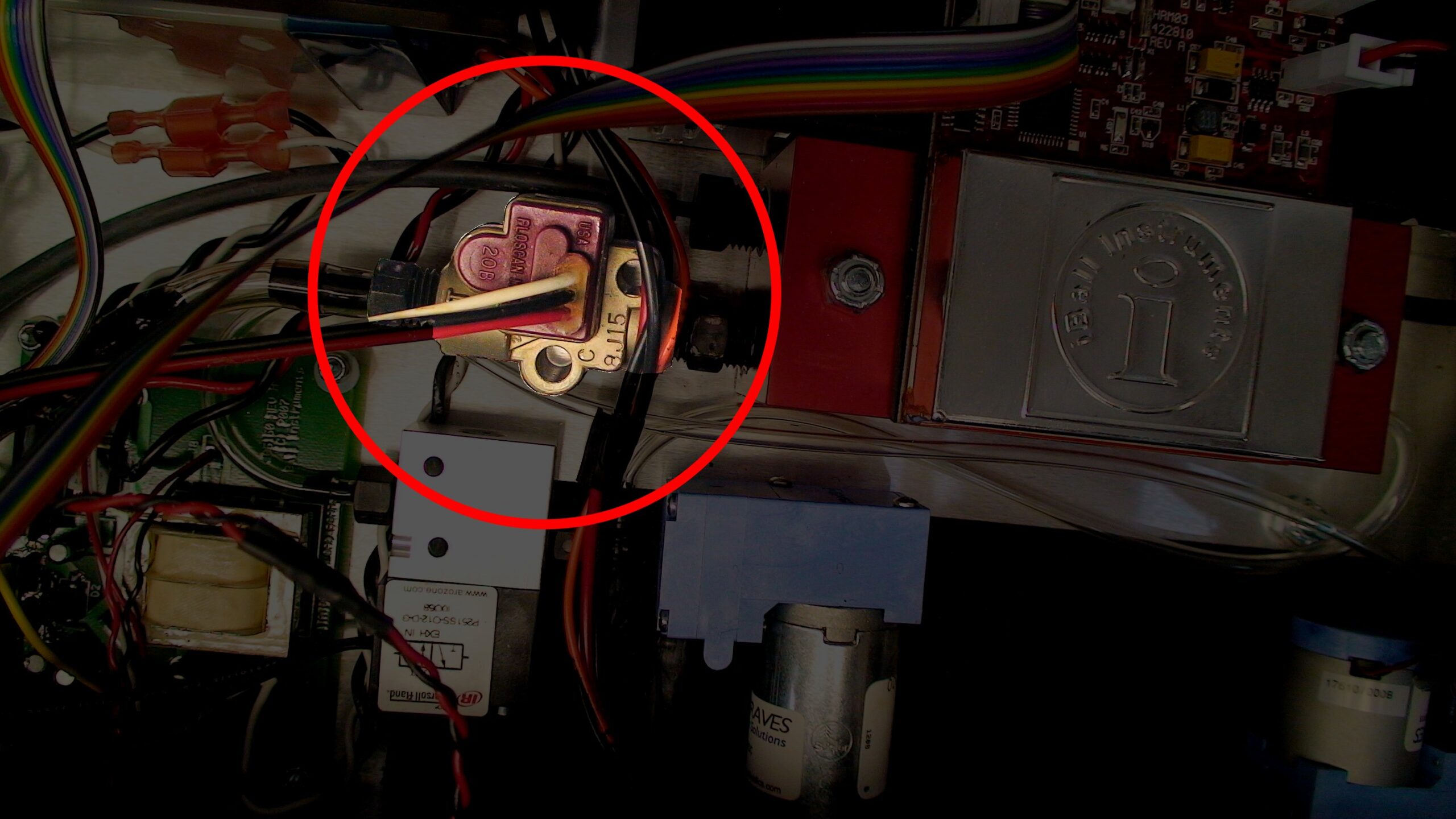
d) While watching either the LCD on the Bloodhound or the real-time data screen on iBall Instruments Gas Chart tap on the housing for the flow meter with the handle on your screwdriver a few times…you can tap it pretty good….see if it starts running again. If so, it was probably shut down with the fins in the *exact* wrong position to be able to start up again and might continue to function. If it starts, you may put the Bloodhound back together again and watch the LPH and continue to “Step 10” below. If it does stop again after it started running ok from what we did here, come back to “Step 6” below.
6) Over-Ride the Flow Meter: To properly override the flow meter, we have to make sure we meet the prerequisites in the section at the top of this tutorial. Please review that section to make sure you do.
NOTE: This step relies on the fact that we know there is -14 mmHg of vacuum for each 100 feet (30m) of quarter-inch/six millimeter (1/4″/6mm) of polyflow tubing. If you are not using this diameter of tubing, then this formula will not work. There are two choices…if you know what your vacuum was before the flow meter began showing problems, then tune the motor speed to that known vacuum in “Step 8” below…otherwise, the Bloodhound should be returned to the iBall Service Center for repairs.
NOTE: This section also relies on the vacuum sensor being in perfect working order. If it is not, then tuning efforts here will prove fruitless and the Bloodhound needs to be returned to the iBall Service Center for repairs.
a) Disconnect the sample line from the inlet on the Bloodhound. It is important that there is *nothing* on this line – only the brass barb on the Bloodhound should be open to the air (any filters or other apparatus connected will offset the “ambient vacuum” number on the Bloodhound which is VERY important when overriding the flow meter).
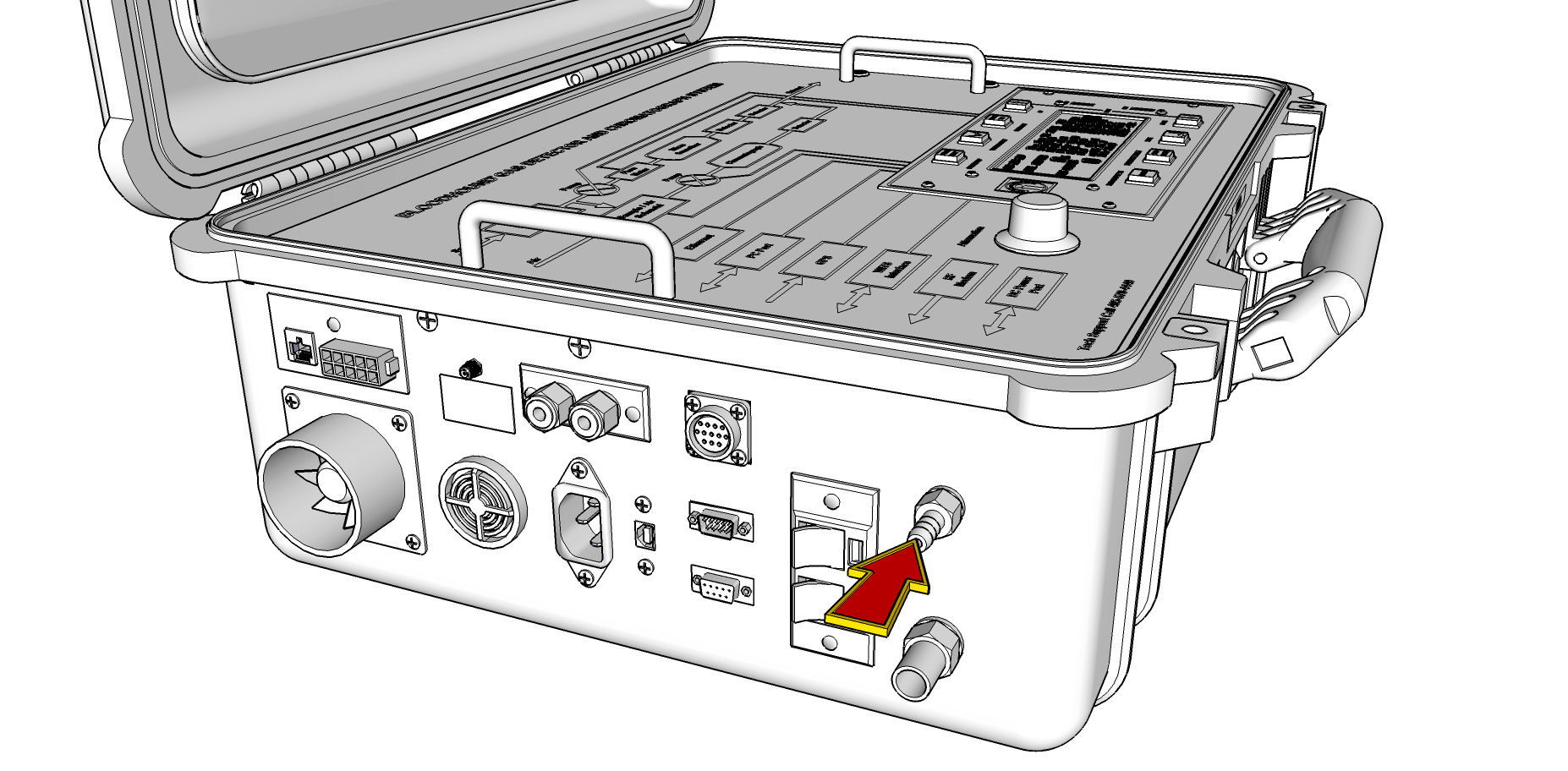
NOTE: If you need to know how to set registers, see the “Other Articles of Interest” section at the bottom of this tutorial.
b) Turn off the “Regulation” of the motor speed as it relates to the flow meter by setting register 11 to zero (0).
c) Set the Motor Speed to a fixed rate starting-point by setting register 10 to fifty (50) (or 50% of motor speed).
7) Let the Bloodhound stabilize and Collect Data for the Formula:
a) Watch the vacuum for a little while until it stops changing (dropping or rising).
b) Write the vacuum (mmHg) number down. This is the number we will use for “ambient-vacuum” in the formula below.
c) Write down the length of your line in 100’s of feet or 30m sections.
8) Calculate the “Magic” Formula for the Vacuum (mmHg) “Target-Range” This is where our Algebra comes in. Because we know that there is very close to -14 mmHg of vacuum for every 100′ of quarter-inch/6-millmeter (1/4″ or 6mm) line when running at 60 LPH on the Bloodhound, we can apply the following formula to come up with a reasonable “target range” of vacuum that will equate to 60 liters per hour (LPH):
vacuum-target-range = ((ambient-vacuum + (-14 mmHg X (polyflow-footage / 100)) +/- 5 mmHg)
EXAMPLE:
a) ambient-vacuum = -6 mmHg.
b) polyflow-footage = 300 feet.
c) vacuum-target-range = ((-6 mmHg + (-14 mmHg X (300 / 100)) +/- 5 mmHg)
d) vacuum-target-range = -48 mmHg +/- 5 mmHg
e) vacuum-target-range is from -43 mmHg to -53 mmHg
c) Using this formula, figure out your target-range and write that down.
9) Adjust the Sample Pump Percentage (%) until the target range is reached.
a) If your current vacuum (mmHg) is below the current range, adjust the Sample Motor Percentage (%) up by changing register 10 to a slightly higher number (usually by five or so points at a time) until you are within the range.
b) If your current vacuum (mmHg) is above the current range, adjust the Sample Motor Percentage (%) down by changing register 10 to a slightly lower number (usually by five or so points at a time) until you are within the range.
c) After making any change to this register, wait a few minutes for the Bloodhound to completely stabilize before making another adjustment. This is to give the vacuum sensor (and if applicable the flow meter) time to adjust to the new motor speed before making another change.
10) Continue to Monitor: When in “Overridden” mode, there are a couple of things you need to keep a closer eye on:
a) It is important to watch the mmHg over time to see if it’s dropping or rising. This can happen if a filter becomes clogged, or if there is a kink or partial blockage in the line. These may not be enough to throw the “Blocked Sample Line” alarm but may impede flow. Because you don’t have a flow meter, the vacuum sensor becomes your new indicator. If there is a gradual or even sharp rise in the vacuum it’s worth looking over the line.
11) Finish the Well and Return the Bloodhound: When you are finished logging the well, it is important to have the flow meter serviced so please make sure the Bloodhound is sent to the iBall Service Center for repairs with a description of the problem. They will either clean the flow meter with a manufacturer- approved solvent, or replace it entirely.